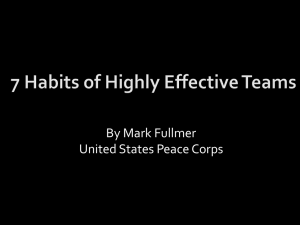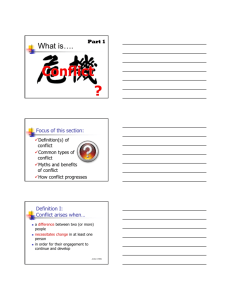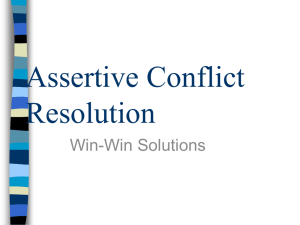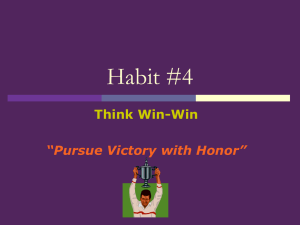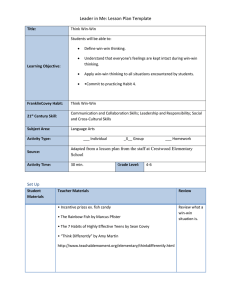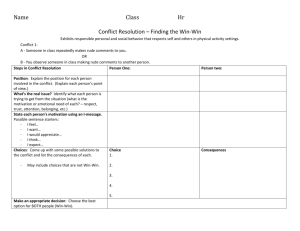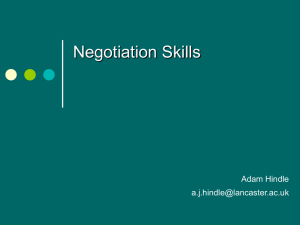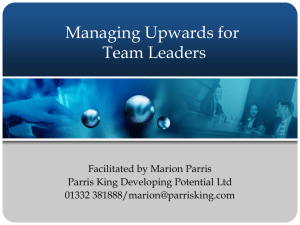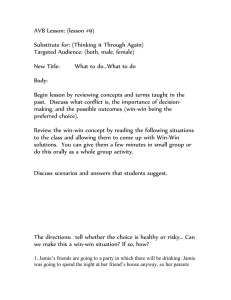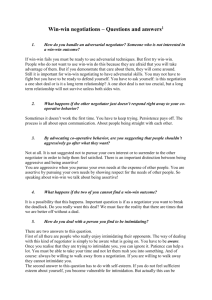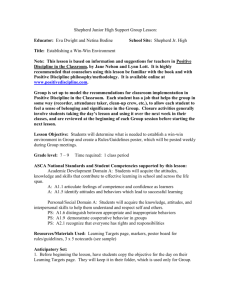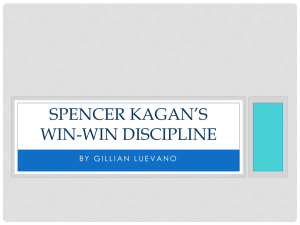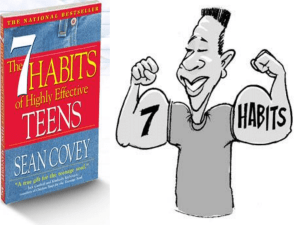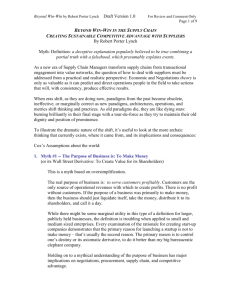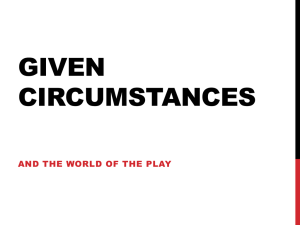Win-Win
advertisement
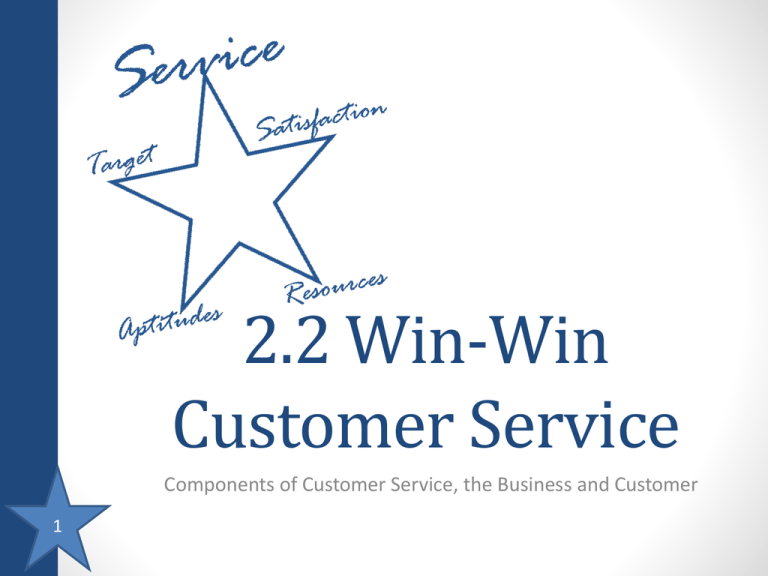
2.2 Win-Win Customer Service Components of Customer Service, the Business and Customer 1 Creating Win-Win Service • Creating a customer service mindset is important • If the mindset of the employees is pro-service, so is the business • EVERY employee in EVERY business will have some conflict • • • • Unhappy customers Unmet needs Shortages Un-kept promises • CONFLICT RESOLUTION is the key to creating a Win-Win Situation 2 When its not there… • Many companies don’t provide great service, or even good service. Why? • Service is usually so straight forward & common sense… • But some companies find this: 1. 2. 3. 4. 5. 3 Employees don’t think management expects great service Employees don’t know how to give great service The employee isn’t a service-oriented person The organization is not service oriented (policies, procedures, systems, priorities are unclear The organization doesn’t treat employees with respect Obstacles • Companies deal with many customers obstacles • • • • • Personality Needs Expectations Complaints Motives • It is important to overcome the obstacles in a positive way: 1. 2. 3. 4. 4 Build a relationship with the customer Discover the needs and wants of the customer Connect emotionally with the customer Create a win-win opportunity for the customer and the business CREATE A WIN-WIN Creating a situation where the customer feels respected and valued, the business profits, and the employee is in control. Win-Win situations sound easy enough… but can be challenging 5 Options in service: • I LOSE - YOU WIN • Company expense, satisfied customer • I WIN - YOU LOSE • company goals met, unsatisfied customer • I LOSE - YOU LOSE • Business loses customer, unsatisfied customer • I WIN - YOU WIN • Company goals met, satisfied customer 6 Creating WIN-WIN • Companies have control over HOW they conduct business • Companies that train employees for Win-Win interactions with customers have a better chance of accomplishment • HOW do you create Win-Win interactions: 1. Build Rapport • With employees and customers 2. Discover What Is Needed • Ask questions to meet needs 3. Develop Trust • Earn the trust of the customer 4. 7 Maintain Relationships • Create a relationship with the customer BUILD RAPPORT • Rapport = creating a cooperative, empathetic relationship • It is important to build a relationship with customers • Especially UNHAPPY CUSTOMERS • • • • • 8 Smile Be Friendly Be Interested Be Sensitive Be Trustful • • • • Be a Problem Solver Be Credible Believe in Your Products Find Common Ground Steps to Build Rapport: 1. L I S T E N . . . 2. RESTATE the problem or complaint 3. ACKNOWLDEGE that you have heard their problem and understand the problem 4. ACT on what your customer is telling you. • • • • There may be something you can do to remedy the situation Do what you can promptly Fixing the situation may create a happy, repeat customer Put the FOCUS of the interaction on FIXING the problem 5. Don’t take it personally 9 DISCOVERY • Discovery = probing for the core needs of the customer • Know the difference between the wants and needs of the customer • What is their goal? What is their intended use? What do they need? • It is important to determine the needs of the customer • • • • • 10 Help to guide them to satisfaction Evaluate the costs of their wants vs. needs Ask questions Recommend appropriate solutions Handle Objections positively • A Pro-Active approach to finding out the desires of the customer has a better chance of repeat business but the customer DEVELOP TRUST • “Trust is earned” • Its important to earn the trust of the customer • Listen actively to their needs • Repeat what they have said • Make sure that you understand their needs • Provide options • Allow customers opportunity to make the final decision • Validate customer decisions • Instill positive feelings • Many purchases are evaluated by how the customer feels 11 Creating A Win-Win Company • Hiring plans provide a platform to find the best employees • Typically look for service-oriented people • People that have an aptitude for customer service • Train employees and the company to respond correctly • Policies and procedures are in place to guide great service • Employees are empowered to provide great service • Products and services are oriented toward great service • Prices, Quantities, Features, Benefits, Delivery, Shipping, Warranty, … • Metrics are in place to measure great service • “Metrics” are measures for service and business 12 Service Providers • Call Centers • Usually have extensive training, procedures, policies • One location with most sales/service associates provides a great training opportunity • https://www.youtube.com/watch?v=rVYiWnzHORo • Retail Sales • Depending on retailer – may have extensive training, procedures, policies in place • Large vs. Small retailers Ex: Target vs. Neighborhood Market • Wholesale Sales • Usually focus on service training with the vendors, clients, and account that are serviced • May have extensive training… will have extensive policies and procedures • Service Industry • Like Retail – may have extensive training for SERVICE (electrician, plumber, doctor, etc) • May have training for service… will have extensive policies and procedures • Large vs. Small Service Providers Ex: America First Credit Union vs. Lawn Care Kid 13 Training • Businesses utilize many different methods to train employees • • • • Role Plays Case Studies Business Simulations Environmental Factors • Customer Service Environment • Hot/Cold • Displays 14 Role Plays • Role plays are situations where employees will ACT OUT or “Play the Role” in a customer service situation • Role plays provide employers to practice or train employees on how specifically to deal with customers requests • Role plays give the employee the opportunity to react to a customer in a “safe” setting for training purposes • Role plays are used by many employers to qualify applicants 15 Case Studies • Case Studies are research based observations of an existing business, focusing on specific tasks • Case Studies have been used for many years in university settings to study business decisions, impact, and teach business/marketing concepts • Harvard School of Business • Case Studies offer insight into decisions, factors, and outcomes which may allow other businesses to either take more calculated risks or steer away from a specific tasks 16 Business Simulations • Business Simulations are computer applications which offer feedback based on specific business decisions • Simulations may measure or evaluate decisions regarding price, layout, budgeting, flow… and translate it into increased or decreased profits 17 Environmental Factors • Different environmental factors also attribute to service issues: • How is the Customer Service Location “Environment” • Is it comfortable? Does it meet the needs of the customer? • Is it lit, heated, cooled appropriately? Is it clean? • Environmental Factors in the Service? • Is it Hot? Cold? Is comfort an issue? • -broken heater, -a/c, - automobile, -vacation, -transportation • -cooler, -freezer, -cold display, -oven, -heater, -hot display • Are Displays Appropriate? • Do displays encourage service? products? company? 18 Assignment Part 1 • Research a Sales-Service company • Identify the following: • • • • • Mission Statement and how it correlates with the company’s service Service Policies in use Service Procedures in use Customer identification – who is their base customer Plus: • • • • • • 19 Who What When Where Why How of the business’s services Assignment Part 2 • Research a Sales-Service company • Identify the following: (add these to your assignment if you don’t already have them in it) • • • • 20 How are employees trained? What policies for service are in place? What procedures for service are in place? What behaviors or aptitudes are encouraged (in service)?
